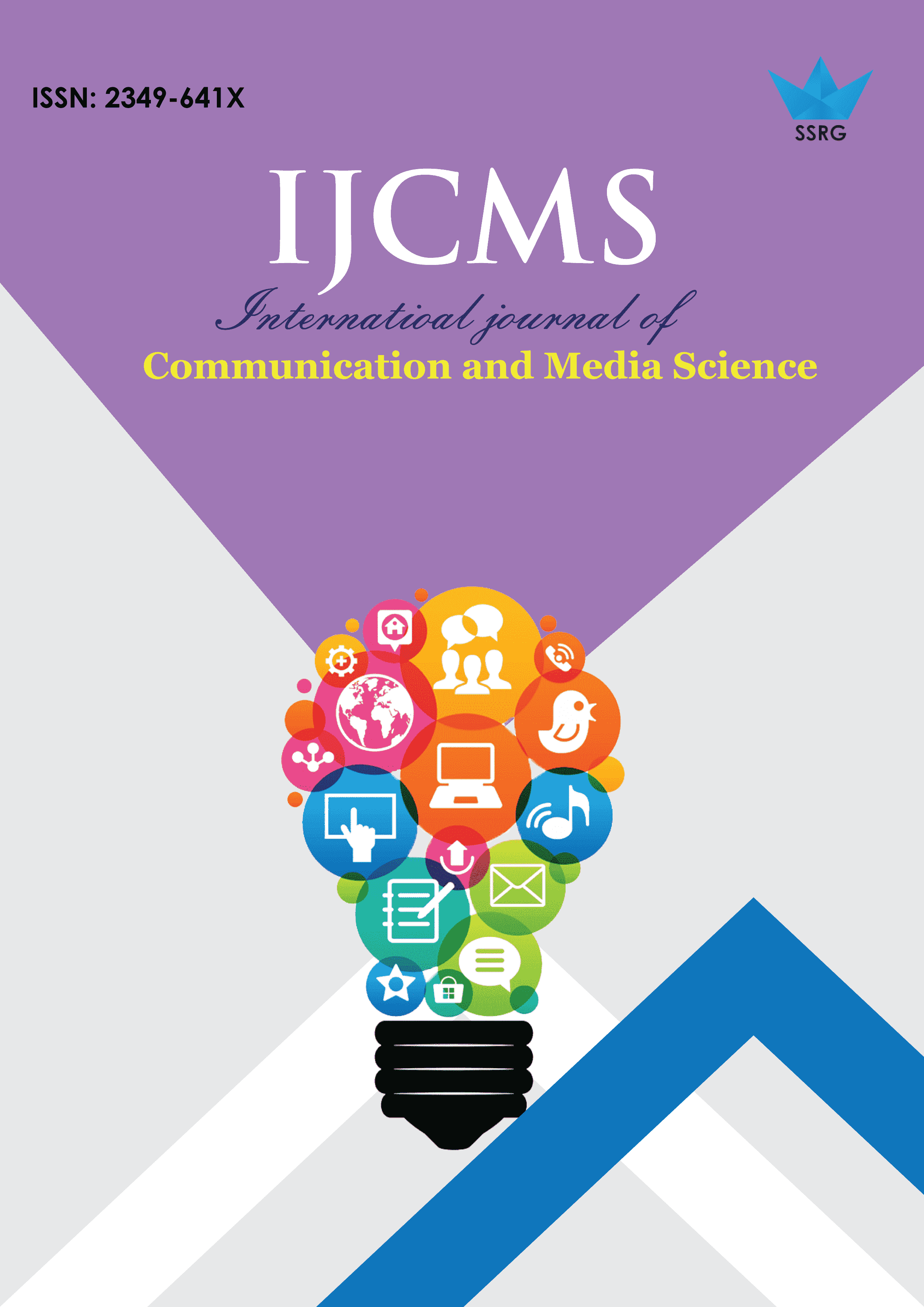Media Construction of the Ashanti Region: A Content Analysis of Daily Graphic and Daily Guide

| International Journal of Communication and Media Science |
| © 2021 by SSRG - IJCMS Journal |
| Volume 8 Issue 1 |
| Year of Publication : 2021 |
| Authors : Dr Kweku Rockson, Asuamah Adade-Yeboah, Dr Edward Owusu |
How to Cite?
Dr Kweku Rockson, Asuamah Adade-Yeboah, Dr Edward Owusu, "Media Construction of the Ashanti Region: A Content Analysis of Daily Graphic and Daily Guide," SSRG International Journal of Communication and Media Science, vol. 8, no. 1, pp. 28-36, 2021. Crossref, https://doi.org/10.14445/2349641X/IJCMS-V8I1P105
Abstract:
This study examines the extent to which major variables like ownership and ideological inclination distinguish between how the state-owned and the privately-owned leading daily newspapers, Daily Guide and Daily Graphic, portray issues related to the Ashanti region. The study employed content analysis as its methodology. A total of 27 issues that were published by the two newspapers in the six months period, January-June, 2015 in which the study was conducted were used for analysis. It was found in the study that the Daily Guide published more favorable stories on the Ashanti region than Daily Graphic in the time of the study. However, it cannot be concluded that Daily Guide is highly Ashanti region biased because the attributes to justify such a conclusion are minimal. It was also found that both papers published more stories on political themes than any other themes. The Daily Graphic was also found in the study to have published more stories on the Ashanti region than the Daily Graphic.
Keywords:
Media, Construction of Reality, Ashanti Region, Content Analysis
References:
[1] Adofo, A. A., Newspaper coverage of cocaine crime issues in Ghana: A content analysis of Daily Graphic and Daily Guide, (Unpublished MA Thesis), University of Ghana, Legon, (2015).
[2] Adoni, H. & Mane, S., Media and the social construction of reality: Toward an integration of theory and research, Communication Research, 11 (1985) 476-490.
[3] Akhavan-Majid, R. and Ramaprasad, J., Framing, and ideology: A comparative analysis of US and Chinese newspaper coverage of the Fourth United Nations Conference on Women and the NGO Forum, Mass Communication & Society, 1(3/4) (1998) 131-152.
[4] Altschull, J. H., Agents of power: the role of news media in human affairs, New York: Longman, (1984).
[5] Andrews, K. T. & Caren, N., Making the news: Movement organizations, media attention, and public agenda, American Sociology Review, 75(6) (2010) 841-866.
[6] Berger, P. & Luckmann, T., The social construction of reality. London: Penguin Books, (1996).
[7] Chaffee, S. H. & Berger, C. R., What communication scientists do. In C. R. Berger & S. H. Chaffee (Eds.), Handbook of communication science , Newbury Park, CA: Sage Publications, (1987) 99-122.
[8] Danker-Dake, J. A., U. S. media coverage of Africa: A content analysis of the New York Times from 2003 to 2007. (Unpublished master thesis), Oklahoma State University, Stillwater: USA, (2008)
[9] Dapatem, D. A. & Donkor, K. B., Ashanti Region: Political hotbed, Graphic Online, (2016).
[10] Dominick, J. R., The dynamics of mass communication, New York: McGraw-Hill Companies Inc, (1996).
[11] Entman, R. M., Framing US coverage of international news: Contrasts in the narratives of KAL and Iran air incidents. Journal of Communication, 41:4 (1991) 6-27.
[12] Eribo, F., & Jong-Ebot, W., Press freedom and communication in Africa, AfricaWorld Press, (1997). ISBN 978-0-86543-551-3.
[13] Goffman, E., Frame analysis: An essay on the organization of experience. New York: Harper and Row, (1974).
[14] Harper, C. & Philo, G., The role of the media construction of public belief and social change, Journal of Social and Political Psychology, 1(1) (2013). doi:10.5964/jspp.v1i1.96.
[15] Hasty, J., The press and political culture in Ghana. Indiana University Press, (2005). ISBN 978-0-253-34524-0.
[16] Herman, E. S. & Chomsky, N., Manufacturing consent: The political economy of the mass media, New York: Pantheon Books, (2002).
[17] Holsti, O. R., Content analysis for the social sciences and humanities. Reading, MA: Addison Wesley, (1969).
[18] Jeffres, L. W., Mass media effects, Prospect Heights, IL: Waveland Press Inc., (1997).
[19] Lacy, S., Riffe, D., Stoddard, S., Martin, H., & Chang, K. K., the Sample size for newspaper content analysis in a multi-year study. Journalism and Communication Quarterly, 4 (2001) 836- 845.
[20] Lee, G., Agenda-setting effects in the digital age: Uses and effects of online media, (Unpublished PhD thesis), The University of Texas, Austin, (2005).
[21] Lippmann, W., The world outside and the pictures in our heads. In W. Schramm & D. F. Roberts (Eds.), The process and effects of mass communication Urbana, IL: University of Illinois Press, (1971) 265-286.
[22] McCombs, M. E. & Shaw, D. L., The agenda-setting function of mass media, Public Opinion Quarterly, 36 (1972) 176-187.
[23] Midttun, A., Coutler, P., Gadzekpo, A., Wang, J. & Staurem, E.m, Climate change policy shifts across three continents: Media coverage in Norway, China, and Ghana, CERES21Reports, 5 (2011). http://www.ceres21.org
[24] Nord, D. P., The practice of historical research. In G. H. Stempel, D. H. Weaver, & G. C. Wilhoit (Eds.), Mass communication research and theory Boston: Allyn and Bacon, (2003) 362-385.
[25] Rockson, K., Akosua cartoons in the Daily Guide:Adiscourseanalysis, Journal of Communications, Media & Society, 2(1) (2011) 48-76.
[26] Rogers, S. Kenix, L. J. & thorson, E., Stereotypical photos of emotionality in news photos, Mass Communication & Society, 10(1) (2007) 119-138.
[27] Sarfo-Adu, K., Amponsah, P. F., & Addo-Danquah, R. G., Bias in headlines: Evidence from newspaper coverage of the 2012 Ghana Presidential election petition, International Journal of Language and Linguistics, 3:6 (2015) 416-426.
[28] Shoemaker, P. J. & Reese, S. D., Mediating the message. White Plains: Longman, (1991).
[29] Spitzberg, B. H. & Cadiz, M., The media construction of stalking stereotypes. Journal of Criminal Justice and Popular Culture, 9(3) (2002) 128-149.
[30] Stempel G. H., Content analysis. In G. H. Stempel, D. H. Weaver & G. C. Wilhoit (Eds.), Mass Communication Research and Theory. Boston: Allyn and Bacon, (2003) 201-219.

 10.14445/2349641X/IJCMS-V8I1P105
10.14445/2349641X/IJCMS-V8I1P105